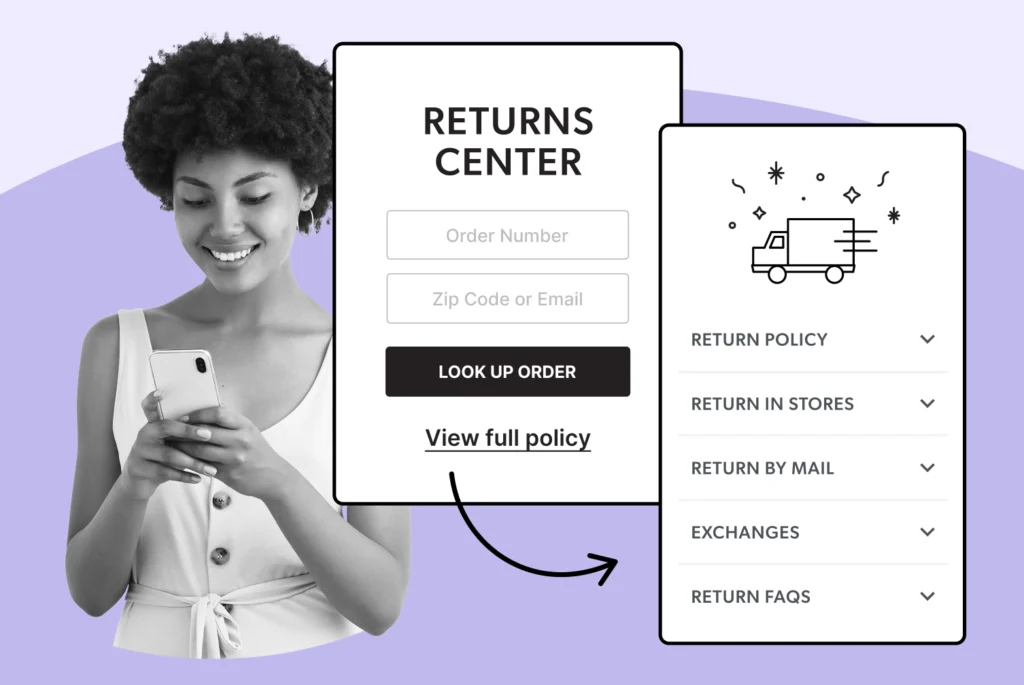
Understanding RMA: What It Means for Shopify & BigCommerce Merchants
Learn how RMA impacts Shopify and BigCommerce merchants, streamlining returns and boosting customer satisfaction. Read the article for essential insights.
Shipping, Tracking & Notifications
Boost customer experience and reduce support tickets
Realtime order and shipment tracking
Proactive order and shipping notifications
AI-Enhanced Discounted Labels
Predictive pre-purchase estimated delivery dates
Self-Serivce branded order tracking
Effortless experience delivered
Identify and Resolve Order Issues
Realtime order and shipment tracking
Make returns profitable and delight customers
Flexibility to define any return destinations & conditions
Simplify returns for your customers and team
Incentivize exchanges over returns
Returns management made easy for your team
Returns management made easy for your team
Easy claims and smart upsells
Understand why your customers are returning
In-Store & Curbside Pickup
Unify the online and the in-store experience
Hassle-free pickup experience for customers
In-Store dashboard to keep operations streamlined
In-Store and Online orders unified
Drive foot-traffic to your stores
Shipping, Tracking & Notifications
Boost customer experience and reduce support tickets
Realtime order and shipment tracking
Proactive order and shipping notifications
AI-Enhanced Discounted Labels
Predictive pre-purchase estimated delivery dates
Self-Serivce branded order tracking
Effortless experience delivered
Identify and Resolve Order Issues
Realtime order and shipment tracking
Make returns profitable and delight customers
Flexibility to define any return destinations & conditions
Simplify returns for your customers and team
Incentivize exchanges over returns
Returns management made easy for your team
Returns management made easy for your team
Understand why your customers are returning
In-Store & Curbside Pickup
Unify the online and the in-store experience
Hassle-free pickup experience for customers
In-Store Dashboard to keep operations streamlined
In-Store and Online orders unified
Drive foot-traffic to your stores
Boost customer experience and reduce support tickets
Realtime order and shipment tracking
Proactive order and shipping notifications
AI-Enhanced Discounted Labels
Predictive pre-purchase estimated delivery dates
Self-Serivce branded order tracking
Effortless experience delivered
Make returns profitable and delight customers
Flexibility to define any return destinations & conditions
Simplify returns for your customers and team
Incentivize exchanges over returns
Returns management made easy for your team
Equip your team for precise return checks.
Understand why your customers are returning
Unify the online and the in-store experience
Hassle-free pickup experience for customers
In-Store Dashboard to keep operations streamlined
In-Store and Online orders unified
Drive foot-traffic to your stores
Find the answer to all your questions
Take a step by step trip through our functionality to see how we can improve your ecommerce processes.
Explore the most comon questions about WeSupply
Calculate the ROI that WeSupply can bring you
Request a no strings attached review of your current shopping experience and missed conversion opportunities
Read actionable articles on how to optimize your post-purchase experience and decrease support tickets
Get inspired by stories of how our customers implemented an effortless post-purchase experience
Wondering if WeSupply is a good fit for you? Read through our use cases to see how we can help you increase conversion & improve CX!
A Deep Dive into Top Companies' Order Tracking & Returns Strategy
Find the answer to all your questions
Explore the most comon questions about WeSupply
Calculate the ROI that WeSupply can bring you
Request a no strings attached review of your current shopping experience and missed conversion opportunities
Take a step by step trip through our functionality to see how we can improve your ecommerce processes.
Read actionable articles on how to optimize your post-purchase experience and decrease support tickets
Get inspired by stories of how our customers implemented an effortless post-purchase experience
A Deep Dive into Top Companies' Order Tracking & Returns Strategy
Wondering if WeSupply is a good fit for you? Read through our use cases to see how we can help you increase conversion & improve CX!

Ecommerce businesses face significant challenges when it comes to protecting customer data. With increasing cyber threats and data breaches, businesses must prioritize security to build customer trust and maintain a positive reputation. A single data breach can result in financial loss, legal issues, and long-term damage to customer relationships. That’s why it’s crucial to establish strong security measures right from the start. By implementing encryption, secure payment processing, and employee training, businesses can reduce risks and ensure a safer shopping experience. Remember, data protection is not just a technical task—it’s an essential part of your brand’s commitment to customer safety. Understanding consumer behavior, particularly how trust and perceived risk influence online purchasing decisions, is key to fostering secure and trustworthy interactions with your customers.
Data breaches can happen to any business, but ecommerce companies are especially vulnerable due to the large amounts of personal and payment information they handle. A well-trained workforce is crucial in preventing a security breach, as employees who are aware of potential threats can better manage sensitive data and respond effectively to incidents. Common issues include weak passwords, phishing attacks, and human errors, which can open the door to cybercriminals. Unfortunately, even a small mistake can lead to massive data exposure. That’s why it’s important to conduct regular security audits, invest in employee training, and stay updated on emerging threats. By addressing these challenges head-on, online stores can better safeguard against cyber threats, protect their customers, and maintain their reputation.
To safeguard shopper data, ecommerce businesses need a reliable and consistent IT/IS system. Regular maintenance and updates are essential to avoid vulnerabilities and ensure optimal performance. Implementing routine QA checks can help identify potential issues early, minimizing the risk of system failures. In addition to technical upkeep, it’s important to have data backup and recovery solutions in place to prepare for unexpected scenarios. Educating employees about best practices also reduces human error, which is one of the biggest security risks. A strong IT/IS foundation not only protects data but also builds customer confidence.
Payment security is a top priority in ecommerce. Compliance with Payment Card Industry (PCI) standards ensures that customer data is processed securely. Implementing SSL certificates encrypts data transmitted between customers and your website, protecting sensitive information like credit card details. SSL also helps build customer trust by displaying the HTTPS protocol, which is a key factor for improving search engine visibility and reassuring shoppers that their data is safe. Staying PCI compliant and maintaining SSL certificates are critical for safeguarding customer transactions and fostering a secure online shopping environment.
Collecting only relevant data that aligns with business goals not only respects customer privacy but also reduces the risk of data breaches. Understanding customer demographics can help tailor marketing efforts, making them more effective and targeted. Avoid gathering unnecessary personal details, as excessive data collection can become a liability. Focus on collecting only what you need to complete transactions or improve user experience. Additionally, make sure to inform customers about the data you collect and how it will be used. This transparency builds trust and demonstrates your commitment to safeguarding their information.
Using strong authentication methods like two-factor authentication (2FA) and multi-factor authentication (MFA) significantly increases account security. Encourage customers to set strong, unique passwords and utilize password managers. Implementing 2FA adds an additional layer of security by requiring users to verify their identity through a secondary method, such as a mobile device. Educating customers about creating secure passwords and the importance of authentication can help minimize unauthorized access and protect sensitive information. Additionally, incorporating fraud prevention measures such as secure payment processing and advanced fraud detection techniques is essential to safeguard online transactions and customer information from cyber threats.
Encryption is one of the most effective methods for protecting sensitive data. By converting information into a coded format, encryption makes it unreadable to unauthorized users. Implementing encryption for payment data, personal information, and communication between your server and customer devices adds a critical layer of security. Utilize encryption protocols like SSL/TLS and ensure that any data stored on your servers is encrypted as well. Regularly update encryption algorithms to maintain robust protection. With encrypted data, even if cybercriminals access it, they won’t be able to make sense of the information. Additionally, encrypting transactional data, such as purchase history and order value, is crucial for safeguarding this invaluable information.
Human error remains one of the top causes of data breaches. Therefore, educating employees about data security is essential. Conduct regular training on identifying phishing attempts, creating strong passwords, and securely handling customer data. Develop a clear protocol for reporting suspicious activity. Training should be an ongoing process, especially as cyber threats evolve. Encourage a culture of security awareness where employees feel responsible for protecting customer information. With proper education, your team can become the first line of defense against data breaches. Additionally, implementing monitoring systems can help detect and prevent fraudulent activities in real time.
Outdated software is a major security risk. Cybercriminals often exploit vulnerabilities in unpatched systems. Regularly updating your website’s content management system (CMS), plugins, and themes reduces the risk of attacks. Choose reputable, well-maintained plugins and avoid those with known vulnerabilities. Implementing automatic updates can help keep your systems secure without requiring constant manual checks. Always test updates on a staging site before applying them live to avoid disruptions. Staying current with software updates ensures your ecommerce site remains protected. Additionally, staying informed about emerging trends in cybersecurity threats can help you proactively address potential vulnerabilities.
Secure payment processing is vital for protecting customer financial data. Use reputable payment gateways like PayPal, Stripe, or Shopify Payments, which are designed to handle transactions securely. Always ensure PCI compliance to minimize the risk of data breaches. Implementing tokenization and encryption helps protect credit card information during transactions. Additionally, use 3D Secure for extra authentication and monitor payment processes for suspicious activity. A secure payment system builds customer confidence and reduces the risk of fraud. Trust and security in digital transactions are crucial for maintaining consumer confidence and influencing purchasing behaviors in e-commerce.
Credit card security is a crucial aspect of ecommerce businesses, as it directly affects customer trust and loyalty. To ensure credit card security, online retailers must implement robust security measures, such as encryption and secure connections, to protect sensitive customer information. This includes using Secure Sockets Layer (SSL) certificates, which encrypt data transmitted between the customer’s browser and the ecommerce website. Additionally, ecommerce businesses must comply with Payment Card Industry (PCI) standards, which provide a framework for securing credit card data. By prioritizing credit card security, ecommerce businesses can minimize the risk of data breaches and protect their customers’ personal and financial information.
Not every employee needs access to sensitive customer data. Implement role-based access controls to restrict data access to only those who need it for their job functions. Conduct regular audits to ensure that permissions remain appropriate as roles change. By minimizing data exposure, you reduce the risk of unauthorized access and data leaks. Limiting data access is a simple yet effective way to enhance your ecommerce security strategy. A comprehensive understanding of data access needs is crucial for optimizing these security measures.
Adding an extra layer of security with 2FA can significantly reduce the risk of unauthorized account access. Require users to verify their identity using something they know (like a password) and something they have (like a mobile device). Implementing 2FA for customer logins and administrative accounts enhances security. Authentication apps, such as Google Authenticator, make this process easy and reliable. Including 2FA in your security strategy reduces the risk of account takeovers. Effective online security practices, such as data encryption and two-factor authentication, can enhance consumer trust and mitigate risks associated with online transactions.
Constantly monitoring site activities helps detect suspicious behavior early. Implement monitoring tools that track user interactions, failed login attempts, and unusual patterns. Automated alerts can notify your team when potential security threats arise. Analyzing logs regularly helps identify vulnerabilities and refine your security measures. Monitoring and logging provide invaluable insights that help safeguard customer data. Additionally, managing web traffic by collecting and analyzing user data is crucial for understanding shopper behavior while ensuring compliance with privacy regulations.
Customer experience and loyalty are key factors in the success of ecommerce businesses. To create a positive customer experience, online retailers must provide a secure and user-friendly online environment, offer relevant and personalized marketing strategies, and ensure timely and efficient customer support. Moreover, ecommerce businesses must prioritize customer loyalty by implementing targeted marketing strategies, offering loyalty programs, and providing valuable insights into customer behavior patterns. By doing so, ecommerce businesses can build strong relationships with their customers, increase customer retention, and drive business growth. A positive customer experience also encourages customers to leave positive reviews, which can help to attract new customers and increase sales.
Data protection regulations, such as the General Data Protection Regulation (GDPR) and the California Consumer Privacy Act (CCPA), play a crucial role in ensuring the security and privacy of customer data. Ecommerce businesses must comply with these regulations by implementing robust data protection measures, such as data encryption, secure data storage, and access controls. Additionally, ecommerce businesses must provide transparent and clear information about their data collection and usage practices, and obtain explicit consent from customers before collecting and processing their personal data. By complying with data protection regulations, ecommerce businesses can minimize the risk of data breaches, protect their customers’ sensitive information, and maintain a positive business reputation.
Ecommerce security tools are essential for protecting online retailers from security threats, such as data breaches, fraudulent transactions, and identity theft. Some of the most effective ecommerce security tools include firewalls, intrusion detection systems, and encryption software. Additionally, ecommerce businesses can use security information and event management (SIEM) systems to monitor and analyze security incidents, and implement two-factor authentication (2FA) to add an extra layer of security to customer accounts. By using these ecommerce security tools, online retailers can create a secure ecommerce environment, protect their customers’ sensitive information, and prevent financial loss due to security breaches. Regular security audits and penetration testing can also help to identify vulnerabilities and ensure that the ecommerce platform is secure.
When it comes to keeping your ecommerce business secure in the long run, staying proactive is key. Regularly updating your security protocols is essential because new threats pop up all the time, and what worked yesterday might not be enough tomorrow. It’s a good idea to stay informed about the latest cybersecurity trends—this way, you’re always one step ahead of potential risks. Whether it’s new malware, phishing tactics, or data breach methods, knowing what’s out there helps you adapt quickly. On top of that, continuously optimizing your data protection strategies ensures that your defenses remain strong as your business grows and evolves. By making security a regular part of your business routine, you not only protect your customers but also build trust and a positive reputation that lasts. Leveraging electronic word-of-mouth (e-WOM) as a valuable tool can further enhance your brand visibility and customer loyalty.
Handling returns securely is just as important as protecting customer data during purchases. One key strategy is to avoid using third-party call centers, which can expose sensitive information to external risks. Instead, opt for in-house return management systems that allow you to maintain control over customer data. Another effective approach is to offer secure digital return portals, which not only make the process more convenient for customers but also ensure that their information is handled safely. These portals allow customers to initiate returns without sharing data with external parties, reducing the risk of data breaches. By prioritizing secure return processes, you demonstrate a commitment to protecting customer data at every stage of the shopping journey. Additionally, secure return processes can help mitigate negative reviews by reducing perceived risk and enhancing customer satisfaction.
Combat inconvenience with proactivity & self service
Book a quick call with our experts to see how WeSupply can help you make returns easy for your customers with a beautiful, self-service solution that makes their experience easier while also providing new ways to lower costs and earn back revenue.
In today’s ecommerce landscape, protecting shopper data is just as important as delivering a smooth return experience. That’s where WeSupply comes in. As a 360° post-purchase solution, WeSupply helps ecommerce brands provide secure, efficient, and data-conscious return processes that boost customer trust and operational efficiency—all while helping you retain revenue and reduce fraud.
Here’s how WeSupply contributes to a safer, smarter return experience:
Fully Automated Return Policy – Enforce consistent return rules to minimize manual handling and reduce exposure to data breaches.
Auto-Identify Potential Fraud – Instantly detect suspicious return behavior and prevent abuse before it impacts your bottom line.
Return Item Inspection – Gain deeper insights into return reasons and product condition without compromising customer data.
Instant Return Scam Resolution – Automatically flag and resolve scam attempts without customer confrontation.
Shipping Protection & Free Returns – Offer peace of mind to shoppers while securing your revenue.
Cash Back Loyalty – Reward legitimate returns with loyalty incentives, keeping customers engaged safely.
POS and In-Store Returns – Centralize data across channels without risking disjointed or insecure processes.
WeSupply doesn’t just make returns easy—it makes them safe. By combining fraud prevention, secure automation, and smart tracking into one platform, WeSupply ensures your customers’ data stays protected from checkout to return. Book a Demo today!
Simplify Returns for Your Customers and Support Team
Book a quick call with our experts to see how WeSupply can help you: simplify the Return experience with just a few clicks, reduce customer service calls and manual processing, notify your customer about their refund, automate returns and reduce user error.
Creating a secure and trustworthy ecommerce environment starts with proactive, consistent data protection practices—from collecting only essential customer information to using strong encryption, two-factor authentication, and keeping systems up to date. These measures protect not only your customers’ privacy but also your brand’s reputation and long-term success.
WeSupply takes this a step further by helping merchants build trust through secure, automated, and customer-friendly return processes. With features like a self-service returns portal, automated return policies, fraud detection, return item inspection, and shipping protection, WeSupply helps minimize data exposure and prevent return-related abuse—while delivering a seamless, branded post-purchase experience.
By integrating security into every return and exchange, WeSupply allows you to reduce operational risk, protect shopper data, and increase customer loyalty. Prioritizing data protection isn’t just about compliance—it’s about building a brand your customers can rely on.
Stay vigilant, stay secure, and let WeSupply help your ecommerce business thrive with confidence and peace of mind. Get Started with WeSupply!
Collecting only the necessary information reduces the amount of sensitive data stored, which lowers the risk of data breaches. It also helps streamline the shopping experience, making customers more comfortable sharing their information.
Additionally, integrating and analyzing data from various customer interactions across multiple channels can provide actionable insights, manage large volumes of data, and optimize user experiences.
Two-factor authentication adds an extra layer of protection by requiring users to verify their identity through a second method, like a code sent to their phone. This makes it much harder for hackers to access accounts, even if passwords are compromised.
Marketing specialists leverage various types of customer data, such as transactional, behavioral, demographic, and engagement data, to gain valuable insights into customer behavior. This understanding allows them to personalize marketing campaigns and enhance user experiences, which leads to more effective strategies and improved business outcomes.
Security updates should be applied as soon as they are available to protect against new threats. Regularly updating software, plugins, and systems ensures that vulnerabilities are patched quickly, keeping customer data safe.
WeSupply uses a secure self-service returns portal and automated workflows to minimize manual data handling, reducing the risk of data exposure or breaches.
Yes! WeSupply automatically detects suspicious return activity, flags potential scams, and supports item inspections to protect your business from fraud.
Yes. WeSupply has an Official Shopify App. You can download it and start integrating with your Shopify Store.
Yes, WeSupply has an official extension for Magento. The WeSupply x Magento integration allows for automating order tracking experiences, reducing customer inquiries, automating shipping email and SMS notifications, and providing a fully branded order tracking experience
Yes, WeSupply has an official BigCommerce App. You can integrate WeSupply with your BigCommerce store to improve your post-purchase customer experience.
Learn How To Create Successful Post Purchase Email Campaigns
Build an effective post-purchase email flow that helps you increase customer satisfaction and drive revenue growth!

Learn how RMA impacts Shopify and BigCommerce merchants, streamlining returns and boosting customer satisfaction. Read the article for essential insights.

Explore the defining traits of Gen X in our comprehensive guide. Understand their values, challenges, and contributions. Read the article for insights!

Explore the pros and cons of a 30-day return window for buyers and sellers. Understand the impact on purchases and sales!

Discover effective return policy page examples that can boost customer trust and satisfaction. Enhance your business strategy!

Explore the pros and cons of Buy Now Pay Later plans for your business. Determine if it’s the right fit for your customers!

Explore the defining traits of Gen X in our comprehensive guide. Understand their values, challenges, and contributions. Read the article for insights!

Explore the pros and cons of a 30-day return window for buyers and sellers. Understand the impact on purchases and sales!

Explore the legal aspects of return policies and whether they constitute a legal agreement. Learn how this impacts your shopping experience. Read more.

Discover why including Shopify returns labels in the box can be a costly mistake. Six compelling reasons to reconsider this practice!